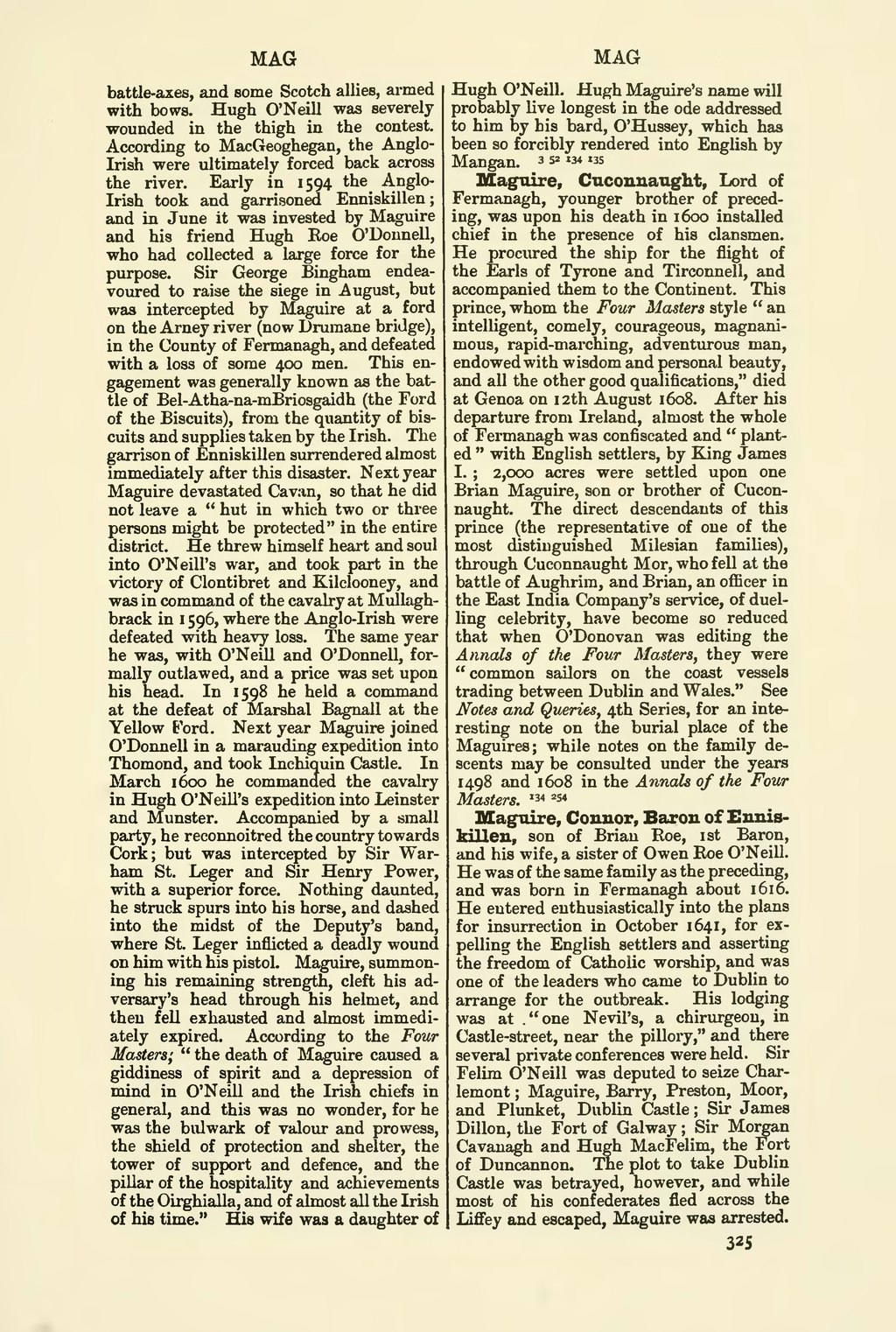MAG
battle-axes, and some Scotch allies, armed with bows. Hugh O'Neill was severely wounded in the thigh in the contest. According to MacGeoghegan, the Anglo- Irish were ultimately forced back across the river. Early in 1594 the Anglo- Irish took and garrisoned Enniskillen ; and in June it was invested by Maguire and his friend Hugh Roe O'Dounell, who had collected a large force for the purpose. Sir George Bingham endea- voured to raise the siege in August, but was intercepted by Maguire at a ford on the Arney river (now Drumane bridge), in the County of Fermanagh, and defeated with a loss of some 400 men. This en- gagement was generally known as the bat- tle of Bel-Atha-na-mBriosgaidh (the Ford of the Biscuits), from the quantity of bis- cuits and supplies taken by the Irish. The garrison of Enniskillen surrendered almost immediately after this disaster. Next year Maguire devastated Cavan, so that he did not leave a " hut in which two or three persons might be protected" in the entire district. He threw himself heart and soul into O'Neill's war, and took part in the victory of Clontibret and Kilclooney, and was in command of the cavalry at Mullagh- brack in 1 596, where the Anglo-Irish were defeated with heavy loss. The same year he was, with O'Neill and O'Donnell, for- mally outlawed, and a price was set upon his head. In 1598 he held a command at the defeat of Marshal Bagnall at the Yellow B'ord. Next year Maguire joined O'Donnell in a marauding expedition into Thomond, and took Inchiquin Castle. In March 1600 he commanded the cavalry in Hugh O'Neill's expedition into Leinster and Munster. Accompanied by a small party, he reconnoitred the country towards Cork; but was intercepted by Sir War- ham St. Leger and Sir Henry Power, with a superior force. Nothing daunted, he struck spurs into his horse, and dashed into the midst of the Deputy's band, where St. Leger inflicted a deadly wound on him with his pistol. Maguire, summon- ing his remaining strength, cleft his ad- versary's head through his helmet, and then fell exhausted and almost immedi- ately expired. According to the Four Masters^ " the death of Maguire caused a giddiness of spirit and a depression of mind in O'Neill and the Irish chiefs in general, and this was no wonder, for he was the bulwark of valour and prowess, the shield of protection and shelter, the tower of support and defence, and the pillar of the hospitality and achievements of the Oirghialla, and of almost all the Irish of his time." His wife was a daughter of
MAG
Hugh O'Neill. Hugh Maguire's name will probably live longest in the ode addressed to him by his bard, O'Hussey, which has been so forcibly rendered into English by
3 52 X34 135
Maguire, Cuconuaught, Lord of Fermanagh, younger brother of preced- ing, was upon his death in 1600 installed chief in the presence of his clansmen. He procured the ship for the flight of the Earls of Tyrone and Tirconnell, and accompanied them to the Continent. This prince, whom the Four Masters style " an intelligent, comely, courageous, magnani- mous, rapid-marching, adventurous man, endowed with wisdom and personal beauty, and all the other good qualifications," died at Genoa on 12th August 1608. After his departure from Ireland, almost the whole of Fermanagh was confiscated and " plant- ed " with English settlers, by King James I. ; 2,000 acres were settled upon one Brian Maguire, son or brother of Cucon- naught. The direct descendants of this prince (the representative of one of the most distinguished Milesian families), through Cuconnaught Mor, who fell at the battle of Aughrim, and Brian, an oflScer in the East India Company's service, of duel- ling celebrity, have become so reduced that when O'Donovan was editing the Annals of the Four Masters, they were " common sailors on the coast vessels trading between Dublin and Wales." See Notes and Queries, 4th Series, for an inte- resting note on the burial place of the Maguires; while notes on the family de- scents may be consulted under the years 1498 and 1608 in the Aiinals of the Four Masters. '^4 =54
Magtiire, Connor, Baron of Ennis- killen, son of Brian Roe, ist Baron, and his wife, a sister of Owen Roe O'Neill. He was of the same family as the preceding, and was born in Fermanagh about 161 6. He entered enthusiastically into the plans for insurrection in October 1 64 1, for ex- pelling the English settlers and asserting the freedom of Catholic worship, and was one of the leaders who came to Dublin to arrange for the outbreak. His lodging was at ."one Nevil's, a chirurgeon, in Castle-street, near the pillory," and there several private conferences were held. Sir Felim O'Neill was deputed to seize Char- lemont ; Maguire, Barry, Preston, Moor, and Plunket, Dublin Castle ; Sir James Dillon, the Fort of Galway ; Sir Morgan Cavanagh and Hugh MacFelim, the Fort of Duncannon. The plot to take Dublin Castle was betrayed, however, and while most of his confederates fled across the Liffey and escaped, Maguire was arrested.
32s
